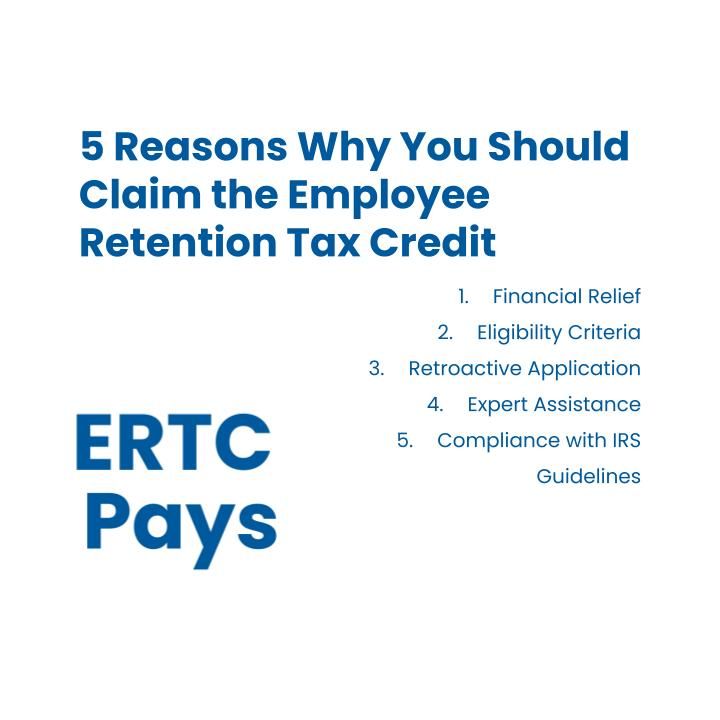Important Points
- The ERTC (Employee Retention Tax Credit) is a government incentive to help businesses keep employees during tough times.
- Businesses can claim up to $7,000 per employee per quarter in 2021 if they meet eligibility requirements.
- ERTC is different from the PPP (Paycheck Protection Program), and businesses can benefit from both if they qualify.
- Understanding eligibility criteria is crucial, including revenue declines or full/partial suspension of operations due to COVID-19.
- ERTC Tax Credit Advisors can help businesses navigate complex IRS rules and maximize their tax credits.
ERTC Tax Credit Overview for Small Businesses
Small businesses have faced unprecedented challenges in recent years, and the Employee Retention Tax Credit (ERTC) has emerged as a vital lifeline. This tax credit was designed to support businesses in retaining their workforce during the economic downturn caused by the COVID-19 pandemic. Understanding how the ERTC works can be crucial for business owners looking to ease their financial burdens.
What is ERTC and Why Was It Created?
ERTC, or the Employee Retention Tax Credit, was established in March 2020 as a component of the CARES Act, or the Coronavirus Aid, Relief, and Economic Security Act. The main goal of the ERTC is to incentivize businesses to keep their employees on the payroll, even in times of decreased revenue. The ERTC accomplishes this by offering a refundable tax credit to businesses, providing them with the financial assistance they need to keep their employees.
How is ERTC Different from the Payroll Protection Program?
It’s natural for business owners to ask what sets the ERTC apart from the Payroll Protection Program (PPP). Both are designed to help businesses keep their employees, but they work in different ways. The PPP provides forgivable loans to cover payroll costs, while the ERTC offers a direct tax credit against employment taxes. It’s important to note that businesses can apply for both, but they can’t use the same wages to claim both benefits.
“The PPP is a loan that may be forgiven, whereas the ERTC is a tax credit that reduces your tax liability directly.”
It is important for businesses to understand these distinctions in order to maximize their benefits from both programs. By strategically using both, businesses can ensure they receive the maximum amount of support.
Updates and Amendments After 2020
Since it was first introduced, the ERTC has seen a number of changes designed to increase its scope and impact. At first, the credit was limited to 50% of eligible wages, up to $10,000 per employee per year. However, later laws increased this to 70% of eligible wages per quarter in 2021, greatly enhancing the possible credits for businesses.
These modifications indicate the government’s continued pledge to aid businesses throughout the pandemic. For business owners to fully take advantage of the ERTC, it’s crucial to stay updated on these changes.
Advantages of Applying for ERTC
Applying for the ERTC provides multiple benefits to businesses grappling with decreased income and the difficulties of keeping their workforce intact. Let’s delve into some of these advantages in more detail.
Helping Businesses Stay Afloat
By reducing tax liabilities, the ERTC offers a lifeline to businesses, particularly those with many employees. The savings can be substantial. Plus, the credit can be applied to payroll taxes, which can provide an immediate boost to cash flow. For more insights on how to maximize Employee Retention Tax Credit benefits, explore our detailed guide.
For instance, a company with 10 workers, each qualifying for a quarterly credit of $7,000, could get up to $70,000 in tax credits per quarter. This sort of financial assistance can be crucial in keeping a business afloat during difficult periods.
Workforce Retention Benefits
Aside from financial support, the ERTC plays a crucial role in helping businesses keep their staff. With incentives for keeping employees on the payroll, businesses can preserve their stability and avoid the costs associated with rehiring and retraining.
Understanding What Costs and Expenditures Qualify
Knowing what counts as eligible wages is crucial for getting the most out of ERTC benefits. Eligible wages are the compensation paid to employees during times of financial hardship. This includes wages paid when business operations are fully or partially suspended or when there is a significant decrease in gross receipts.
Not only can wages be included, but certain health plan expenses can also be included, which expands the scope of eligible expenses. Making sure all qualifying expenses are accounted for can help businesses claim the maximum credit available.
Who Can Apply for the ERTC?
Businesses need to meet certain requirements to be eligible for the ERTC. These requirements are based on how COVID-19 has affected their operations and revenue.
Eligibility Criteria for Business Revenue
- Businesses must show a significant drop in gross receipts compared to a similar quarter in 2019.
- To be eligible, businesses must have a decline of 50% or more in 2020 or 20% or more in 2021.
- Businesses that were fully or partially shut down due to government orders are also eligible.
It is vital to meet these revenue experience requirements for eligibility. Businesses must carefully examine their financials to see if they meet the required criteria.
Staff Size and Salary Restrictions
Your ERTC eligibility is largely dependent on the size of your company. The number of employees you have can impact how much credit you’re eligible for. For example, in 2020, companies with 100 or fewer full-time employees could claim the credit for all employee wages, regardless of whether the company was operational or not. In 2021, this limit was raised to 500 or fewer full-time employees, allowing more companies to take advantage of the credit.
It is imperative that you accurately calculate the number of full-time employees you have, as defined by the IRS, to ensure you are eligible for the correct amount of credit. Full-time employees are generally defined as those who work 30 or more hours per week or 130 hours per month. This definition is used to maintain consistency across different tax credits and to ensure businesses apply the rules correctly.
“In 2021, businesses with 500 or fewer full-time employees can take advantage of the ERTC for wages paid to employees, even if they are working.”
Knowing these limits and definitions is crucial to get the most out of your credit and avoid possible discrepancies during an audit.
How to Apply for the ERTC Tax Credit
The process of applying for the ERTC might seem overwhelming at first, but breaking it down into smaller steps can make it easier. Here’s how you can begin:
Collecting Information and Documenting
Prior to submitting your claim, collect all required documentation. This should include payroll records, quarterly financial statements, and any government orders related to COVID-19 that impacted your business. Keeping accurate records is important, as these will be the foundation of your ERTC claim.
Make sure your documents clearly indicate any periods of decreased income or times when operations were halted. This proof is vital for showing the IRS that you qualify. Also, keep track of any PPP loans you’ve gotten, as they can have an impact on your ERTC calculations.
Keep your paperwork neat and easy to find. This will not only make it easier to file your taxes, but it will also help you be ready if the IRS ever decides to audit you.
Filling Out IRS Form 941
If you want to claim the ERTC, you must complete IRS Form 941, also known as the Employer’s Quarterly Federal Tax Return. This is the form where you will report your employment taxes and claim the credit. It is very important that you fill out this form correctly to make sure your claim is processed without any issues. For more information, you can refer to these essential quarterly tax reporting tips for businesses.
Here are the essential steps to filling out Form 941:
- Declare the total amount of wages and tips you’ve paid to your employees.
- Compute the credit by multiplying the qualified wages by the applicable percentage (50% for 2020, 70% for 2021).
- Deduct the credit from your total employment taxes due.
After you’ve completed the form, submit it in accordance with IRS instructions. Make sure your calculations are correct and all information is accurate to prevent delays or rejections. For more details, you can read about maximizing Employee Retention Tax Credit benefits for businesses.
Submitting on Time
It’s critical to submit your paperwork on time. The IRS has set deadlines for when Form 941 needs to be submitted, usually at the end of each quarter. If you miss these deadlines, you may face penalties or a delay in receiving your credit. To make sure you submit on time, keep a calendar of when you need to file and set reminders.
Deciphering the Possibility of an IRS Audit
Despite the ERTC offering substantial advantages, it also carries the risk of an IRS audit. Anticipating this can save you from unnecessary headaches and wasted time. In an audit, the IRS will scrutinize your records to verify adherence to ERTC regulations.
Make sure your paperwork is detailed and clearly shows you qualify. Keeping your records tidy and complete can make the audit process easier and help sort out any differences fast. For more guidance, refer to this business tax audit preparation checklist.
The Importance of ERTC Tax Credit Advisors
ERTC Tax Credit Advisors are critical in assisting businesses to navigate the intricate process of claiming the credit. This expertise can be extremely beneficial, particularly for businesses that are not well-versed in tax regulations.
Advantages of Expert Assistance
Securing the services of an expert consultant can offer a variety of advantages. They can help guarantee your claim is correct and comprehensive, minimizing the chance of mistakes that could postpone or endanger your credit. Consultants keep up to date with the most recent IRS rules, making sure your company stays in line with changing regulations.
In addition, advisors can provide strategic advice on how to maximize your credit while minimizing potential liabilities. This advice can be especially helpful for businesses with complex financial situations.
Understanding Complex Tax Laws
The ERTC requires understanding a maze of tax laws and guidelines. Advisors can make this process easier, helping you comprehend the rules and how they affect your business. Their knowledge can also be vital in deciphering government orders and figuring out your eligibility based on operational impacts.
Effect on Successfully Claiming Credits
Having an advisor can greatly affect the success of your ERTC claim. They can assist in identifying eligible wages, ensuring proper documentation, and navigating you through the filing process. This assistance can boost the chances of a successful claim and help you get your credit quickly. For more information on how an advisor can help, visit ERTC Express.
Final Suggestions for Small Businesses
When thinking about claiming the ERTC, remember a few key suggestions. First, evaluate your eligibility thoroughly. Make sure you meet the criteria for revenue decline or operational suspension and correctly count your full-time employees.
Secondly, make sure you collect and sort all your documents properly. This will not only make filing easier but also protect you if the IRS decides to audit you. Lastly, think about getting professional help. An ERTC Tax Credit Advisor can help you understand the credit better and make sure you get the most out of it.
Evaluating Your Business’s Eligibility
Invest the necessary time to evaluate your business’s eligibility for the ERTC. Examine your financial records and any government mandates that impacted your business activities. This evaluation will give you a clear understanding of your qualification and assist you in making educated choices about applying for the credit.
Keep in mind, the ERTC can provide substantial financial assistance, but it necessitates meticulous planning and implementation. By adhering to these suggestions and utilizing the resources at your disposal, you can effectively claim the credit and bolster your business in difficult times.
Getting the Most from the ERTC
Understanding the specifics of your business that can affect your credit is crucial to maximizing the benefits of the ERTC. This means correctly determining your eligibility, maintaining thorough records, and having all your paperwork in order before you file. An ERTC Tax Credit Advisor can guide you through these steps and make sure you don’t miss any potential benefits.
It’s important to claim your ERTC benefits as soon as you can. This can help you improve your cash flow during difficult times. Also, think about how the ERTC interacts with other tax credits and programs that your business might qualify for, like the PPP.
Adhering to IRS Rules
When you’re claiming the ERTC, it’s crucial to follow IRS rules. If you don’t, you could face fines or lose the credits, which could be expensive for your company. To make sure you’re following the rules, keep detailed records of all the paperwork related to your ERTC claim. This should include payroll records, financial statements, and any relevant government orders.
Keeping up with changes to the ERTC program is crucial because the rules and eligibility requirements may change. Make sure to frequently check the IRS’s guidelines and speak with a tax advisor to ensure your business stays within the law and gets the most out of the credit.
Commonly Asked Questions
- What is the main goal of the ERTC?
- How is ERTC different from PPP?
- Who is eligible for the ERTC?
- What paperwork is required to apply for ERTC?
- What occurs during an IRS review of ERTC applications?
- Can a business apply for ERTC if they have received PPP funds?
- How can ERTC Advisors assist in the application process?
- Are there cut-off dates for applying for the ERTC?
The ERTC was designed to provide financial support to businesses by offering tax credits for keeping employees on payroll during economic hardship. This allows businesses to keep their staff and maintain operations despite a decrease in revenue.
In contrast to the PPP, which gives forgivable loans for payroll expenses, the ERTC provides a direct tax credit against employment taxes. This makes the ERTC especially useful for businesses aiming to lower their tax liability while keeping their employees.
Why was the ERTC created?
The ERTC was created to incentivize businesses to retain their employees during tough economic times, especially those brought on by the COVID-19 pandemic. By offering a refundable tax credit, the ERTC helps businesses cover payroll expenses and keep their teams intact.
Businesses experiencing decreased revenues can greatly benefit from this support, as it can help them avoid layoffs and continue operations until conditions improve. The ERTC’s ultimate goal is to stabilize the economy by supporting both businesses and employees.
What sets ERTC apart from PPP?
ERTC and PPP are both designed to help businesses through the pandemic, but they each do it in their own way. PPP provides forgivable loans that can be used for payroll and other eligible expenses. ERTC, on the other hand, offers a tax credit against employment taxes.
Both programs can help businesses, but they need to make sure that the wages they use for PPP loan forgiveness aren’t also claimed under the ERTC. Knowing these differences is crucial to getting the most out of both programs.
Who is eligible for the ERTC?
For a business to be eligible for the ERTC, it must meet certain requirements. These requirements include having a substantial decrease in gross receipts or having operations fully or partially suspended due to government orders related to COVID-19. To maximize Employee Retention Tax Credit benefits, businesses should ensure they understand these eligibility criteria thoroughly.
Moreover, the total number of full-time employees your company employs can also impact your eligibility. In 2021, companies with 500 or fewer full-time employees were able to claim the credit for all wages paid, irrespective of whether they were operational or not. Therefore, it’s crucial that you accurately determine your company’s eligibility to claim the ERTC.
What paperwork do you need to claim the ERTC?
If you’re planning to claim the ERTC, you’ll need to make sure you have all the necessary paperwork to prove your eligibility. Here’s what you’ll need, along with some common business tax credit myths that you should be aware of:
For a successful ERTC claim and a streamlined filing process, it is essential that you have the following documents organized and readily accessible: maximize employee retention tax credit benefits.
- Records of wages paid to employees.
- Financial statements for each quarter showing revenue declines.
- Government orders that led to operational suspensions.
- Any PPP loans received, if applicable.
What occurs when the IRS audits ERTC claims?
Should the IRS audit your ERTC claim, they will examine your paperwork to confirm it adheres to program rules. This includes confirming your eligibility, the correctness of your wage calculations, and the validity of any government orders impacting your business.
Keeping your paperwork in order and maintaining clear records can help make your audit process run more smoothly and can also help you resolve any discrepancies faster. If you are subject to an audit, it’s a good idea to talk to a tax advisor to make sure your records meet the requirements set by the IRS.
Is it possible for businesses to claim ERTC if they got PPP funds?
Indeed, businesses can claim the ERTC even if they got PPP funds. However, they need to make sure that the same wages are not used to claim both the ERTC and PPP loan forgiveness. This requires careful monitoring of payroll expenses and strategic planning to maximize benefits from both programs.
What role do ERTC Advisors play in the filing process?
ERTC Advisors are crucial in helping you work through the intricacies of claiming the credit. They help guarantee that your claim is correct and thorough, minimizing the chance of mistakes that could postpone or endanger your credit. For a comprehensive approach, you might consider using a top tax advisor to evaluate your tax credit opportunities.
Advisors keep up to date with the latest IRS guidelines and can provide strategic advice on how to maximize your credit and minimize any potential liabilities. This can be particularly useful for businesses that have complex financial situations or are not familiar with tax regulations.
Is there a deadline to claim the ERTC?
Yes, there are deadlines to claim the ERTC. Typically, businesses have to file their claims by the end of the quarter after the quarter in which the wages were paid. If you miss these deadlines, you could face penalties or a delay in getting your credit. For more information on eligibility and filing, visit ERTC Express.
Keeping track of filing dates by marking them on a calendar and setting reminders is essential to ensure that you submit everything on time. Being organized and proactive can help you meet these deadlines and secure your ERTC benefits.





